
Whole House Humidifier Buying Guide
 Our homes and bodies need moisture to thrive. Overly-dry air can have negative health effects and even damage wood floors or furniture. That’s why it’s best to keep your home’s humidity between 40-60%.
Our homes and bodies need moisture to thrive. Overly-dry air can have negative health effects and even damage wood floors or furniture. That’s why it’s best to keep your home’s humidity between 40-60%.
The best way to maintain healthy humidity levels is with a whole-house humidifier, also known as a furnace humidifier. Unlike single-room or personal humidifiers which only add moisture to a small space, furnace humidifiers take care of your whole house and require less maintenance.
Our whole house humidifier buying guide prepares you for choosing the right unit for your home. If you still have questions after reading this, please contact us.
Absolute vs Relative Humidity
 There are two measurements of humidity: absolute and relative. When it comes to your home, you should be more concerned with relative humidity.
There are two measurements of humidity: absolute and relative. When it comes to your home, you should be more concerned with relative humidity.
Absolute humidity is, simply, the percentage of water vapor in the air, regardless of temperature.
Relative humidity is the amount of water vapor in the air at a certain temperature compared to the maximum amount of water the air can hold at that temperature. Warmer air can hold more water than colder air. So, at 70 °F, the same amount of water vapor will take up less space and feel less humid than at 20 °F.
This is important to know because your home's humidity levels and how you feel will depend on the temperature. During winter, you feel particularly dry because you're constantly heating your home. The water vapor takes up less space in the warm air and decreases the relative humidity, which is why humidifiers are often most needed during the heating season.
Types of Whole House Humidifiers
There are three main types of whole-home humidifiers: evaporative, steam, and self-contained. The first two connect directly to your central forced-air heating system. The last one works independently. Humidifiers are controlled by a humidistat, which monitors relative humidity levels.
Evaporative Humidifiers
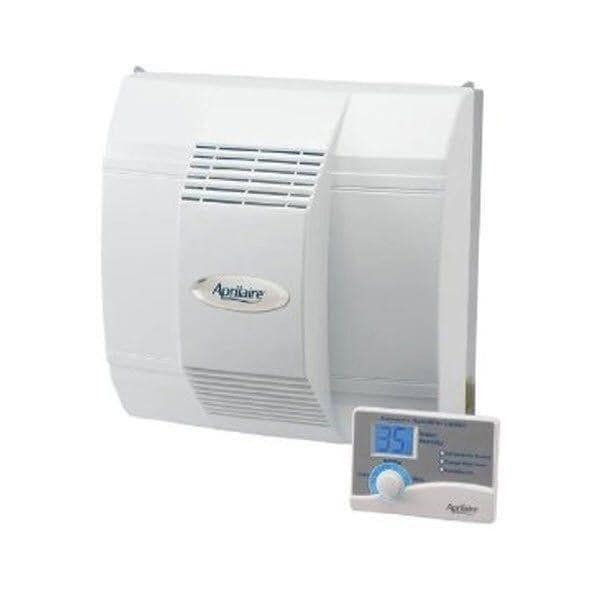 An evaporative humidifier adds moisture to the warm, dry air coming out of your furnace. It uses a direct water line to constantly supply water to a humidifier pad. As the warm furnace air blows across the wet pad, it evaporates the water and absorbs it.
An evaporative humidifier adds moisture to the warm, dry air coming out of your furnace. It uses a direct water line to constantly supply water to a humidifier pad. As the warm furnace air blows across the wet pad, it evaporates the water and absorbs it.
Evaporative humidifiers are further divided into two main types:
- Bypass humidifiers redirect furnace air through a bypass duct. The bypassed air blows over the humidifier pad to pick up moisture before being distributed around the home. A bypass humidifier can be installed on either the supply or return duct and requires two connections to the ductwork. If you don't need the humidifier running, you can simply close the bypass damper.
- Powered humidifiers use a fan to pull water across the humidifier pad, which allows for a better distribution of moisture in the air than in a bypass type. They connect directly to the supply side ductwork.
At the beginning of the heating season, the damper on the return duct is switched from summer mode to winter mode so that the return air will be directed over the humidifier pad.
Both types of evaporative humidifiers use little to no electricity. It’s the heat from the furnace that evaporates the water. They are also both relatively simple and have few moving parts that can fail.
Although less expensive to operate, evaporative humidifiers aren’t very efficient, converting only 20-30% of the water they use into humidity. The excess water needs to be drained. Also, your furnace system needs to be running for evaporative units to work properly. Otherwise, there is no heat source to evaporate the water.
You may decide to go with an evaporative humidifier if you are on a budget but want to add humidity to your entire home. They will get the job done simply and out of sight.
Steam Humidifiers
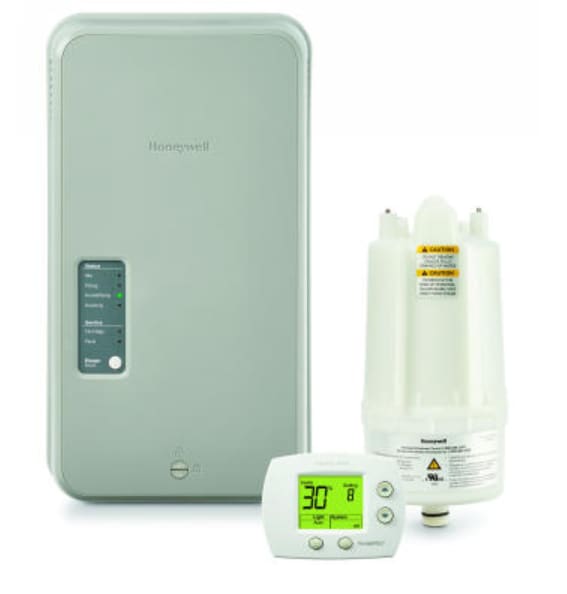 Steam humidifiers store water in a canister instead of using a pad. When it detects low humidity, the steam humidifier electrically boils the stored water into steam, which is then distributed into your furnace duct system.
Steam humidifiers store water in a canister instead of using a pad. When it detects low humidity, the steam humidifier electrically boils the stored water into steam, which is then distributed into your furnace duct system.
The main difference between a whole house steam humidifier and an evaporative humidifier is power. A steam humidifier uses electricity to produce its own power. That means it can run as long as your blower fan is on, whether or not your furnace is running.
As a result of their power draw, steam humidifiers are much more expensive to operate than evaporative models, although they can be up to 90% efficient when it comes to water use. They can be installed without ductwork, which cuts down on labor and material costs.
Overall, steam humidifiers outperform evaporative types because they can provide more consistent levels of moisture, but they will cost you more money.
Self-Contained Humidifiers
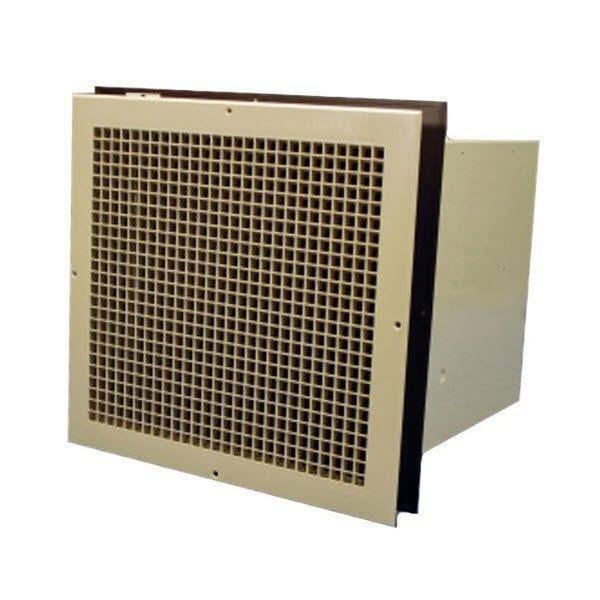 For homeowners who don’t have ductwork, a self-contained whole house humidifier can adequately moisturize their home. These units operate independently of any furnace system, using a fan to circulate humidified air.
For homeowners who don’t have ductwork, a self-contained whole house humidifier can adequately moisturize their home. These units operate independently of any furnace system, using a fan to circulate humidified air.
Self-contained units are your only whole-home humidification option if you have radiant or ductless heat.
What Size Humidifier Do I Need?
Sizing a humidifier for your home depends on two main factors:
- Building Volume: How much space is there to humidify? Building volume is measured in cubic feet. A general rule for getting cubic feet is to multiply your home's square feet by the ceiling height.
For example, if your home is 3,000 square feet and you have 10-foot ceilings, your cubic footage will be 30,000. You can also multiply your home's length, width, and height. - Building Envelope: How drafty is your house? Older homes were built less efficiently and lost air much more quickly than modern homes, which have double-paned windows, better insulation, etc.
Use the following guide to help determine your building envelope, while taking into account your home’s insulation and window efficiency.
| Building Envelope | Insulation (R-Value) | Window Efficiency |
|---|---|---|
 | 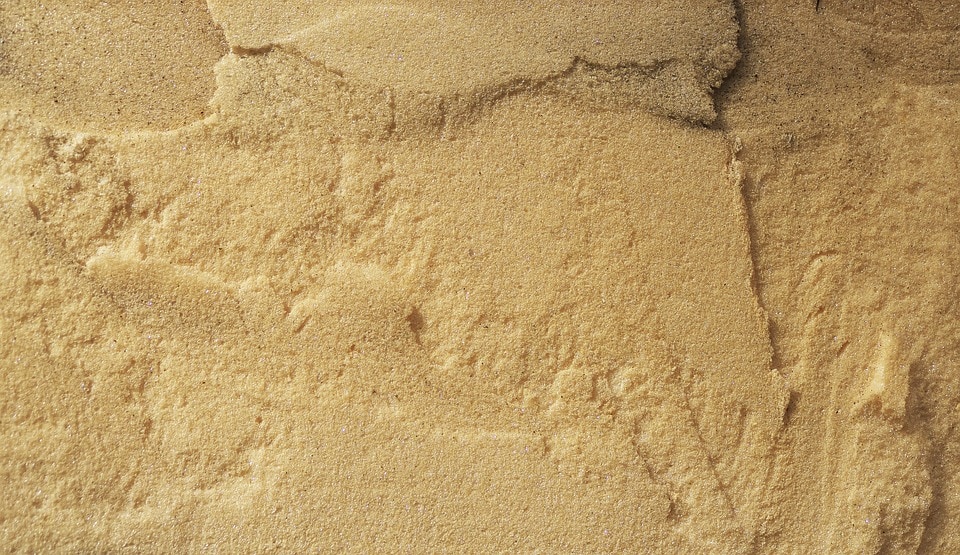 | 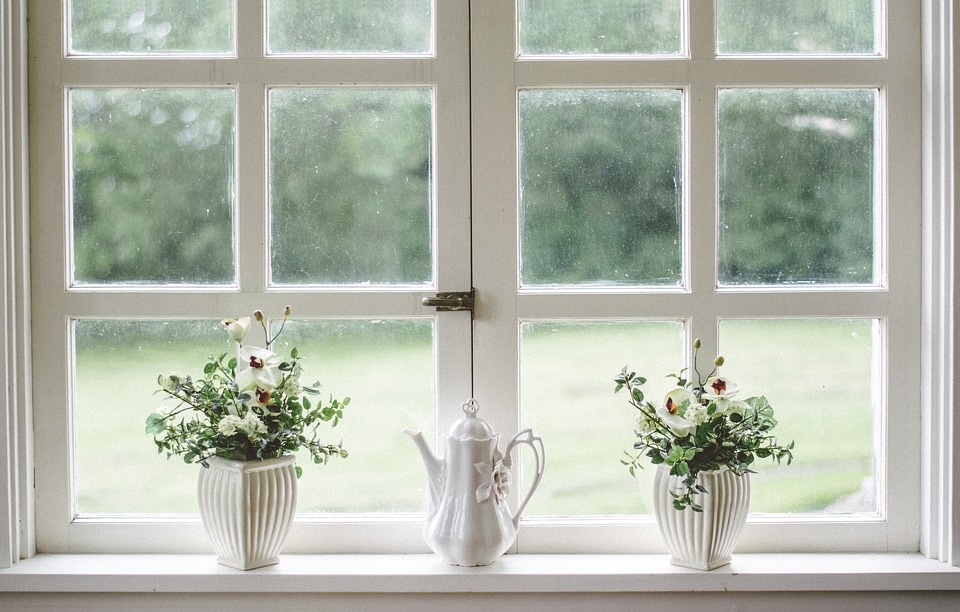 |
| Loose | 0-R9 | Single-Pane |
| Average | R10-R19 | Double-Pane |
| Tight | R20-R30+ | Low-E/Triple-Pane |
Once you know your building envelope and volume, you can use that information to figure out what size humidifier you need, measured in gallons per day.
Use the following table to size your humidifier. Simply find where your Building Volume and Building Envelope meet in the table. That is the number, in gallons per day, that your humidifier will need to be sized for.
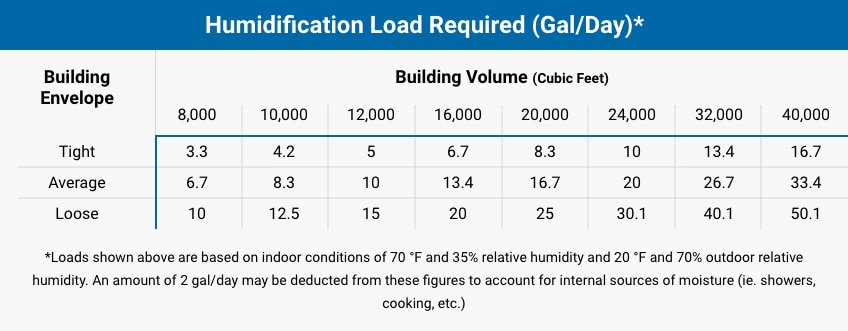
- If using a steam humidifier, select the humidifier that has a capacity greater or equal to the load listed.
- If using an evaporative humidifier with a furnace, double the load listed.
- If using an evaporative humidifier with a heat pump, triple the load listed.
Let's use our example from earlier. Our home has a building volume of 30,000 cubic feet. Now, let's say it has an average building envelope. If we cross-reference those figures in the table, we find that we need roughly a 26.7 gallon-per-day humidifier.
Furnace Humidifier Maintenance
Whole-house humidifiers do not require as much regular maintenance as personal humidifiers, which are very prone to mold and bacteria growth. However, don't set it and forget it.
Evaporative humidifiers need their humidifier pads changed once per year to prevent calcium buildup. Steam humidifiers will need their canister changed out once per year. For both units, test your system to make sure water is able to flow properly and that there are no obstructions or leaks.
Stay Humid
Obviously, you don't want your home too humid. Otherwise, you won't feel comfortable and will get mold and possible structural damage. If your humidity levels are consistently higher than 60% than you might need a dehumidifier.
If humidity levels are lower than 40%, though, it's time to add some moisture. Your home and your body will thank you.

